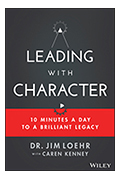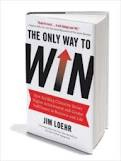The Universal Solvent for Evil
Jim Loehr

In 2011, Simon Baron-Cohen, professor of developmental psychopathology at the University of Cambridge, published The Science of Evil, which argued that evil is the consequence of blocked empathy and compassion.
Without empathy, Baron-Cohen contended, we can turn people into objects, and all that's left is "I." He defined empathy as the ability to identify what someone else is thinking or feeling and to respond appropriately.
For Baron-Cohen, empathy is the most valuable moral resource in the world. It represents a universal solvent for evil.
Neuroscientists have discerned at least 10 regions of the brain are involved in what Baron-Cohen calls "the empathy circuit.” One of these is the orbitofrontal cortex. This is a prefrontal cortex region in the frontal lobes of the brain which is involved in the cognitive process of decision-making. The orbitofrontal cortex helps link our rational and emotional brains. Empathy is both a cognitive understanding and an emotional response.

Neuroscientist Kent Kiehl, after scanning the brains of more than 4,000 prison inmates, found structural impairment in areas connecting thoughts and emotions, most notably in the orbitofrontal cortex.
According to Kiehl, psychopaths think about what's right and wrong but cannot feel it. Healthy moral reasoning incorporates both thinking and feeling. Tragically, the moral machinery of psychopaths restricts this critical integration.
The emotions that play a central role in an individual's healthy moral calculus - and that are blocked in an unhealthy one – include kindness, compassion, caring, and trust, all of which possess the same neuropeptide oxytocin.
Oxytocin consists of nine amino acids and is primarily produced in the nuclei of the hypothalamus. Sometimes referred to as the "love hormone," early research on oxytocin focused on the hormone's ability to strengthen the bond between mother and child.
Oxytocin plasma concentrations rise dramatically during the birthing process. As oxytocin levels increase, social distance closes. Feelings of trust, compassion, empathy, and caring increase.
The empathy circuit, as well as related feelings of kindness, compassion, caring, and trust, not only share a common biochemical substrate (oxytocin) but, more importantly, represent an indispensable source of input in our process of moral deliberation.

As with muscles in the physical body, when the "muscles" of empathy, compassion, and caring are strengthened through training, they become more available to us in our efforts to say or do the right thing.
Owning our moral code requires that we decide where, in our hierarchy of values, empathy, compassion, kindness, and the like fall compared with values such as being a winner, succeeding in competition, and ambition.
Owning our moral code is impossible unless we, as leaders, prioritize values that dictate how we treat and interact with others.
There's something inherently threatening about questioning the ownership and legitimacy of one's moral code. Part of that may be a fear of disrespecting our parents, grandparents, religious teachers, and so forth.
Perhaps we're afraid of what we might find in the searching. Maybe we fear that our identity as a moral person could be destabilized as we probe for answers.
Regardless, it's imperative that we push past doubts and fears, and bring our moral code into full awareness. When we confront the truth about ownership, about how responsible we feel for the beliefs and values that form the bedrock of our sense of right and wrong, we move inexorably toward living an authentic life.
As one of my clients put it, "Now I realize I've been living in a moral fog most of my life. The fog has been steadily lifting since I started asking tough questions and making daily entries into my journal. My moral awareness has significantly improved. I can't say my moral deliberation process is any easier, but I can say I have much greater confidence in whatever moral actions I take because of it."

Just as dedicated practice strengthens motor pathways (called "myelination") for a gymnast, so too dedicated moral practice strengthens neuro pathways to specific parts of the brain that ignite empathy, kindness, humility, and so forth.
When a gymnast decides to move, the primary motor cortex in her brain determines precisely which muscles to activate and with how much force.
In the same way, myelinated connections between our cognitive and emotional brains precisely activate the moral and performance muscles required for flawless execution. Intentional, dedicated practice builds moral competence: You are an "athlete" of character.






